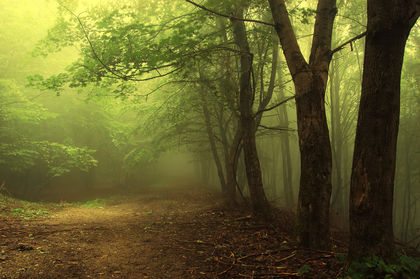Seedless Vascular Plants

When one walks through a contemporary forest, all of the surrounding trees are vascular plants. Wood, which is made up primarily of xylem , and bark, which contains phloem , are the major structural elements of the trunks and stems. These trees produce seeds, whether they be formed within the cones of the pines or within fruits, such as the winged samaras of maples or the fleshy cherries of the cherry tree. In the Carboniferous period a similar hike would also place one in a forest of woody trees, many as large as 98 feet (30 meters) tall, but there would be no seeds produced. These plants were seedless vascular plants, which were propogated by spores. Ultimately they became extinct, leaving behind expansive fossil fuel deposits.
The differences between spores and seeds are extensive. Seeds are multicellular structures that provide a protected place where the egg (n) was to be fertilized by male gamete nuclei (n) in pollen. The resulting cell, called a zygote , is diploid (2n), the same as the original plant that produced it. It repeatedly divides mitotically, while still within the protection of the seed coat, to form an embryo. The embryo may remain dormant for a significant time period but ultimately emerges from the seed when it germinates.
The seedless vascular plants do not have this protection. Their gametes are produced mitotically by a gametophyte (n) that lives independently. There are often many vase-shaped archegonia on these small plants, and the unfertilized egg is inside the base of this structure. The embryo formed following fertilization is not as well protected as one located within a seed. It grows and emerges from the archegonium, where it is exposed to the environment.
These embryos survive best to develop into young sporophyte individuals when they are in moist habitats, whereas seeds can endure more severe conditions and therefore can have wide habitat type distributions. The sporophyte eventually develops rhizomes, underground stems, roots, or rhizoids that serve to absorb water and nutrients and allow independent survival. In the case of the plants of the Carboniferous forests, this development was extensive.
The simplest type of spore production in living seedless vascular plants is found in the leafless whisk fern, Psilotum, a member of the phylum Psilotophyta. This sporophyte (2n) plant, really little more than a branching twig, has many sets of three-fused sporangia, which produce spores through meiosis . These haploid (n) spores grow into minute plants about the size of a small piece of macaroni. These plants have archegonia and small gametangia (which produce the male gametes) to complete sexual reproduction and make new sporophytes.
Many variations on this basic spore-producing alternation of generations life cycle are found in the seedless vascular plants. The carboniferous trees, which are now recognized only through the study of their fossils, most likely had common ancestors with a variety of present-day organisms including the ferns, horsetails, and lycopods.
The modern ferns, phylum Pterophyta, have leaves of varying sizes and shapes and still occur as trees in tropical areas. The descendents in the other groups do not presently attain treelike stature. Horsetails or scouring rushes, phylum Sphenophyta, have ancestors stretching as far back as the Devonian era. A ribbed, silicon-impregnated stem has branches in many species that are whorled and give the plant the appearance of a bottle brush or animal tail.
The phylum Lycophyta includes club mosses, sometimes called ground pines, which in some cases have stems with reduced leaves (microphylls) fused together to look like the foot of an animal. The name lycopodium means "wolf foot," and most likely originated because of this morphological analogy. The selaginellas, which often superficially resemble mosses, are in fact very different from mosses. Their small, leafy green stems are sporophytes (2n) and have vascular tissue. In contrast, the small leaves of mosses are gametophytes (n) and no vascular tissue is present. Shifts like this, from a predominant gametophyte generation to a predominant sporophyte generation represent one of the major trends of evolutionary advance in the plant kingdom.
SEE ALSO Alternation of Generations ; Bryophytes ; Evolution of Plants ; Plant ; Pteridophytes
Dean Cocking
Bibliography
Perry, James W., and David Morton. Photo Atlas for Botany. Belmont, CA: Wadsworth Publishing Company, 1998.
Raven, Peter H., Ray F. Evert, and Susan E. Eichhorn. Biology of Plants, 6th ed. New York: W. H. Freeman and Company, 1999.
Van De Graff, Kent M., Samuel R. Rushforth, and John L. Cawley. A Photographic Atlas for the Botany Laboratory, 3rd ed. Englewood, CO: Morton Publishing Company, 1998.
Comment about this article, ask questions, or add new information about this topic: